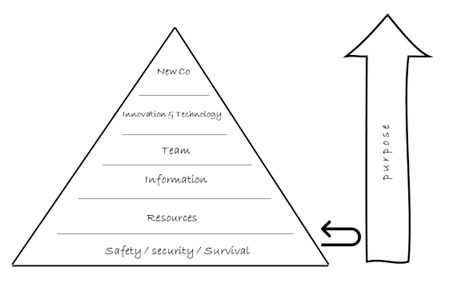COVID-19 is the Black Swan too few saw coming. Our collective failure of imagination contributed to the disruption we’re experiencing as an economy and society. There is no excuse, however, for a failure of imagination now now. All the rules of business have changed, and leaders must prepare in real time for eventualities that were once unthinkable while positioning their organizations for renewed success through radical innovation, accelerated growth in capabilities and newly clarified purpose. In that sense, crisis can be a gift.
Though chaotic, a crisis simplifies, clarifies and unites. Crisis leadership is not about merely managing a situation to preserve the status quo. It is a vehicle for inspiring people and teams to higher levels of performance while catalyzing ideas that open the organization up to new possibilities, ranging from effective responses to current circumstances, to new business models, new products and services, and even new markets.
I wrote about managing in a time of crisis five years ago. I had just finished back-to-back stints as managing director for my company in two different regions that almost immediately devolved into chaos. The first was Greece just as austerity measures plunged the country into economic devastation and social revolt. The second was Ukraine on the eve of mass protests, random sniper fire, and a Russian-backed invasion.
In both cases, every expectation and plan that I went in with got immediately overturned. But my teams came together in unexpected ways to make the organization stronger, more resilient and more innovative, while turning a generation of middle managers into seasoned leaders.
In this time of crisis, I want to pass on some of my perspective and the insights I gained.
Evolving Organization Needs During a Crisis
During extreme uncertainty, speed in decision-making, organizing, and acting is essential but a leader can’t push their agenda successfully without taking into account where people are currently at and what they need.
 The pyramid illustrates what people need from leadership as they adapt from overcoming early shock to helping build a brighter future in an expedited way.
The pyramid illustrates what people need from leadership as they adapt from overcoming early shock to helping build a brighter future in an expedited way.
Early in the crisis, needs will be basic. When the organization gains its footing, needs will evolve as solutions and opportunities become more complex.
Purpose also evolves during a crisis. In my experience, a stale or canned sense of purpose will be the first thing to go when a crisis hits. To bring people together and keep them focused in a rapidly changing environment, you may need to adapt and recalibrate your purpose along the way.
Scenario planning is also critical at each stage of crisis leadership. Old assumptions must be challenged in light of new reality. Leaders must ask (and by modeling, develop that same mindset in others) provocative and probing questions to assess the range and severity of risks and opportunities in a given area or situation. I call these “What If” questions. Then, they must turn quickly to the best possible path with contingency plans already considered. At Amazon, this leadership principle is called, “Have Backbone; Disagree and Commit.”
Let’s look at how evolving purpose and “What If” thinking applies as your team’s or organization’s needs change.
1. Safety / security / survival
To be creative, urgent, resilient and perform under intense pressure, people need some degree of safety, support and security. At level 1, the purpose of the organization is not to deliver on their pre-crisis objectives; it is to see to the fundamental needs of its people.
With COVID-19, employees may face a great deal of uncertainty and even danger. What are leaders doing to see to their fundamental needs? Can healthcare workers get proper sanitation equipment or childcare? Is it possible for employees to get supplies, medicine and medical care, cash for their immediate needs? How about childcare? Is everybody connected remotely?
By asking “What if” questions, leaders can come up with alternatives that support people to continue living and perform basic tasks? Virtual teams, drone deliveries, safety protocols, mental health services, etc.
Can any of these measures be part of a new business model?
Some examples: could grocery store sanitation policies become a new selling point? Will education that combines digital and physical class presence be the new model?
2. Resources
In a crisis, resources will be scarce but essential. Think practically and tangibly. What supplies, tools, and equipment, do your people need to keep the business operations going?
Because of COVID-19, global supply chains are in disarray. What can a manufacturing company do to obtain raw materials or parts? Is there a local supplier or alternative product? Do you have backup plans if those plans fail?
As the crisis deepens and revenue shortfalls intensify, what are the capital needs of the organization. As Sequoia Capital puts it, “In downturns, revenue and cash levels always fall faster than expenses.” Can insurance or alternative funding sources cushion the gap? Can your balance sheet be hedged? How quickly can you optimize your cost basis?
How can you turn resource confusion into opportunity? Can you pool resources, capabilities or capital with competitors, or sell or trade unneeded equipment or supplies?
3. Information
To navigate a new reality effectively, you need to know the facts. How do you get that information? What is your plan for sharing that information among your stakeholders, i.e., your employees, customers, shareholders and suppliers? How can you establish an organized, reliable, accessible and accurate information system?
In a time of crisis, extreme candor works better than withholding, hedging or sugarcoating the truth. Your people need to understand everything to act or respond in real time.
As soon as COVID hit, a Wall Street bank began surveying managing directors regularly about what they were hearing from clients. Not only did this help keep the bankers informed, but the firm used the intelligence for weekly reports and podcasts for clients, and to help find solutions to urgent market needs.
4. Teams
Without leadership, teams fall apart during a crisis. On the other hand, a crisis is an opportunity to accelerate team development under fire.
In Ukraine, I was in the middle of a team development program when the crisis hit. Our efforts were not derailed by the crisis but propelled by it. We came together in a new way, around a very meaningful purpose - to safeguard our employees and resume business operations in spite of the chaos. Along the way, we co-developed systems for sourcing and sharing information, making decisions faster, coordinating efforts, executing effectively, and supporting each other emotionally.
Our team effectiveness scores had soared by the time we measured them again, post-crisis. My team members had also developed leadership skills which made them highly sought-after managers and executives across the global company.
5. Innovation & Technology
The right response to a crisis is innovation. When business as usual is impossible, business processes and even services and products may need to adapt and change. We’ve seen many examples of this during COVID-19. Grocery stores and delivery services are implementing new standards and practices. Hotels are turning into shelters. Cruise ships can become hospitals.
Technology is often the vehicle for transformation. It’s not necessary to invent new devices or digital platforms; just adapt or utilize what already exists. Drones and robots are ready to make deliveries or stock shelves. Video communication platforms are suddenly on overload. Zipnosis, a telemedicine company in business for ten years, saw 2000% plus surge in user volume in two weeks.
6. New Co
During a crisis, many executives think first and foremost in terms of the organization’s survival. This mindset can have drawbacks, however. By scaling back, preserving resources, laying off employees, etc., companies may “save a limb” but lose the patient.
Crisis leaders think in terms of adaptation, innovation and growth. Every crisis forces opportunism in the best sense. In response, your company can redefine the reason for its existence, change its processes accordingly, capture hearts and minds, enter new markets, craft the new-normal and possibly save the planet.
The first mistake in a crisis is underestimating the possible extent of change. The second mistake is preserving your organization to succeed in an environment that is no longer relevant.
Crisis provides a rapid path to overhauling every aspect of your organization, from basic processes to the culture of information sharing and decision making to the purpose of your venture and the business you are in.
The world will not be the same after COVID-19. Many of the companies that thrive in the future will be those that adapt and evolve very rapidly over the coming months.

